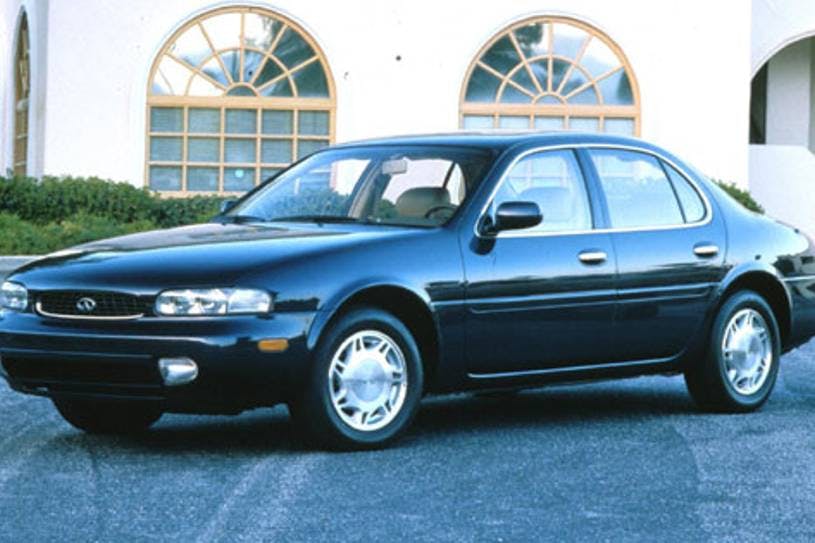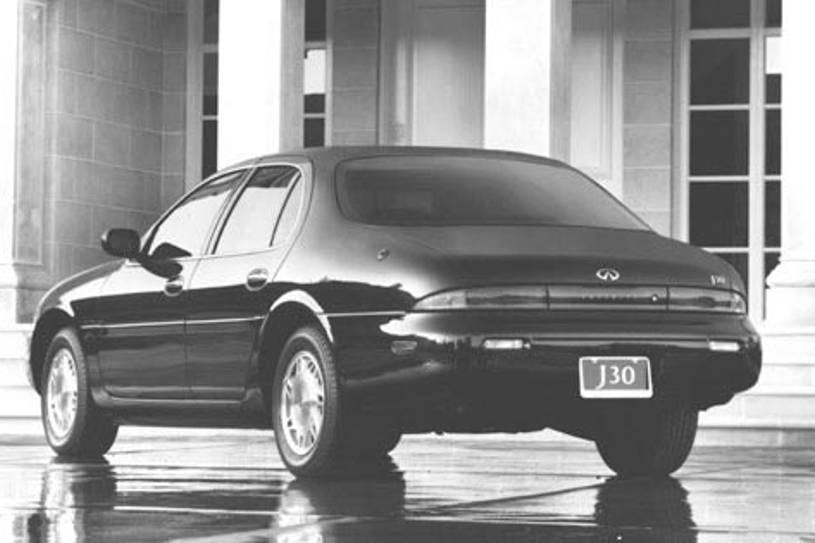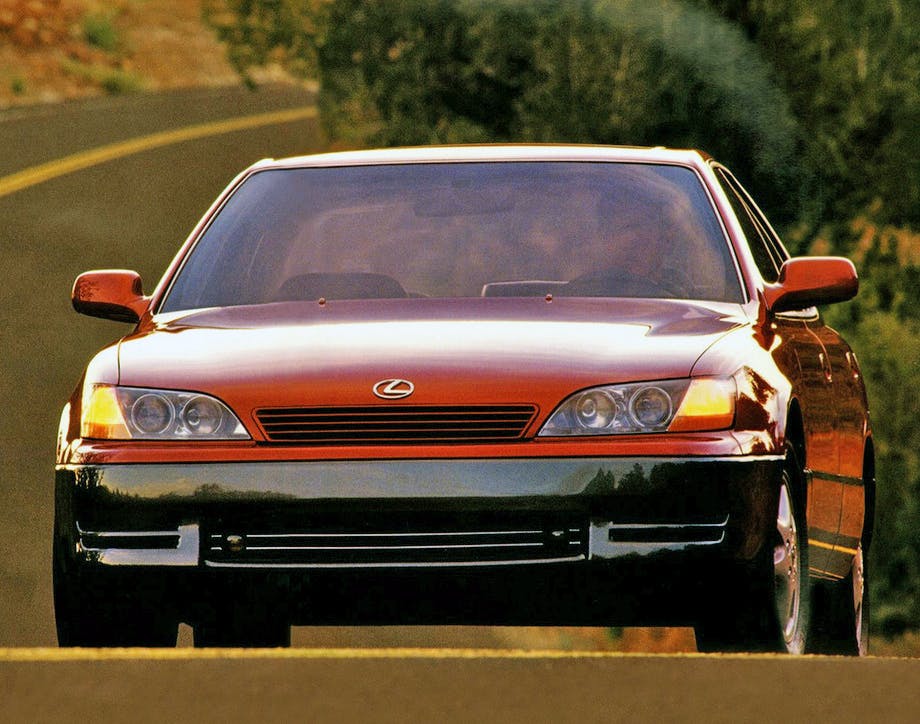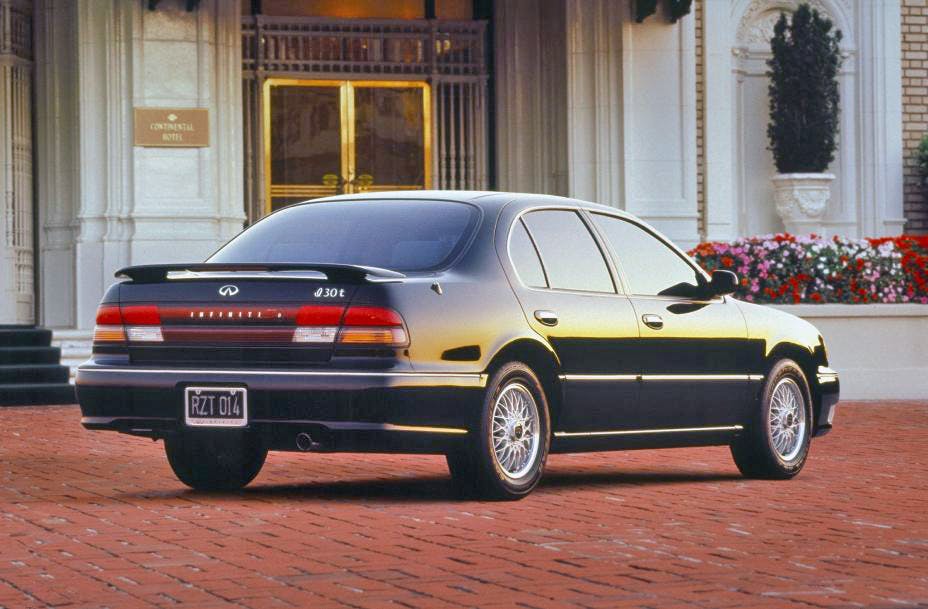The Infiniti J30 Was a Super Yacht for the Masses
Measuring in at a smidge over 108 feet, the Motali mega yacht penned by Nissan designer Alfonso Albaisa came to life in the early 1990s. The design was beautifully relevant enough to earn a coveted award from the Industrial Design Society of America, but its relevance extended far beyond the love thrown at it in yachting fanboi circles. That’s because the Motali’s stern sported an angular band of glass above a curvaceous body with an integrated swim platform. Love it or hate it, that look turned into a car called the Infiniti J30.

Those hard-lined windows below the Motali’s rounded swim platform became the trunk and rear light bar of the short-lived 1993–97 Infiniti J30. The two elements could have fought each other, but Albaisa used the Motali‘s success to refine the surface of the J30’s rear fascias in a similar manner. The path he (and design boss Jerry Hirshberg) took for the J30 was a radical departure from other vehicles in its class, especially considering the outgoing Nissan Leopard–based M30.

The craziest side effect of all this contouring was that the headlights were the same height off the ground as the taillights, a slap in the face to contemporary design trends that demanded a taller rear deck. Conventional wisdom had some merit, as a taller posterior can both increase cargo volume and lower aerodynamic drag. This is a lot to digest for any would-be luxury car buyer, much less one in the early 1990s who had to decide if the upstart luxury brand from Toyota (Lexus) or Nissan (Infiniti) was worth their hard earned cash.
Not to mention the second-generation Lexus ES was already blazing an avant garde path, and it was a bit more logical for a fledgling luxury automaker. The ES had artistic projector headlights in a housing worthy of fine crystal in a chandelier, but everything had a radical sanity associated with its Camry underpinnings. Because we had yet to see who won in the American market, it made sense for Infiniti to go radical in hopes of earning more market share.


Brand loyalty was ready to be earned, and Infiniti struck when the iron was hot. And cribbing lines from a mega-buck mega yacht makes way more sense than Lexus seeking inspiration from things like plaster-filled balloons. Factor in the use of Nissan’s impressive rear-wheel-drive architecture for performance prowess, and the J30 sounded quite appealing. How could Infiniti lose against a tarted-up Camry?
Feel free to consider the Infiniti J30 as a four-door Nissan Z32, as its engine and some rear suspension/drivetrain parts are known to interchange. Nissan platform-sharing folklore aside, executives at Infiniti suggested the J30 was styled to “break away from the tyranny of the wedge.” That’s an insightful statement, as the ovoid Infiniti was a bold alternative to anything even remotely angular from Lexus, BMW, and Mercedes.





Nor did the J30 have any cosmetic connection to the outgoing M30’s worn-out wedge design, a notion that dates back to Italian studios of the 1970s. This car was a trailblazer, and it had a base price of $33,000 that climbed to $34,700 for the touring model with four-wheel steering (among other dynamic and cosmetic enhancements). That’s a fair price for all this performance and luxury, but the J30 was heavily undercut by Lexus when it set the base price of the ES at $26,550.
Although Lexus quickly raised prices ($31,200 in 1994) on its spiced-up Camry, the race was already won thanks to Lexus’ initial push for sales volume in the near-luxury car market. (Its unassailable reputation for the best customer service after the sale didn’t hurt, either.) Proving the point is the fact that Lexus sold 39,652 ES sedans in its first year, more than half of the roughly 70,000 J30s sold during its entire lifespan.


Nissan’s corporate mothership wasn’t doing that great after the bubble economy burst, so the J30’s lukewarm reception with near-luxury buyers must have been a bad omen. BMW and Mercedes presumably did well continuing with a rear-wheel-drive-heavy product portfolio, but the grand slam success of the front-wheel-drive Lexus ES suggested Nissan needed an Infiniti based on the popular Maxima sedan.
Enter the Infiniti I30, a Maxima-based luxo sedan (note the similarities in the doors) that superceded the sculptural J30. It sported an upright posterior and a boxy front end, which officially jettisoned the yacht-rock aesthetic of the J30 before it. The switch to front-wheel drive likely opened up the interior, while the sky-high decklid boosted cargo space from 10.1 to 14.9 cubic feet.
Family sedan substance with a thinner veneer of styling prowess appealed to buyers of near-luxury cars, as perhaps they were looking to move up from the front-wheel-drive family sedans they were used to. While sales figures are hard to find, the I30’s introduction is credited to an increase in Infiniti’s overall sales volume in the mid 1990s. (From 28,910 in 1996 to 41,595 in 1999.)


Shedding the rear-wheel-drive, Z-car adjacent DNA was an unfortunate reality for Infiniti’s answer to the Lexus ES series, but it was the wrong answer. It wasn’t until the Infiniti G35’s release that we saw a revitalization of the J30’s legacy, and this time it worked. While it was a badge-engineered version of the 11th-generation Nissan Skyline, yearly sales regularly topped 50,000 units. A high-water mark of 71,809 sales happened in 2007.
The G35 certainly thrived in the space once occupied by the J30, piloting seas that were previously unreachable. The tie-up with the JDM Nissan Skyline certainly excited many a car enthusiast who knew the model thanks to the Gran Turismo racing simulator, turning Infiniti into a Carnival Cruise line making bank that would humiliate the likes of the Motali mega yacht.
The story of Infiniti’s middle-ground luxury yacht was as convoluted as the life of a stereotypical middle child. (Recall there was a G20 dinghy below, and a Q45 Koru up top.) Perhaps it was tragic, as the J30’s radical, sculptural styling statement was too much for its intended audience. I wager the legacy ended on a high note thanks to the G35 sedan, but turbulent waters were coming if you read between the lines in Motorweek’s review. Phrases like “love it or leave it” and “not thrilled by the results” meant this little Motali had gale force headwinds coming its way.

But that’s only if you neglect to consider the original Nissan Stanza Altima, as it took the oval concept of the Motali to successful highs. Literally, as now the concept had a taller rear end for family-sedan practicality. The taillights weren’t a long spear across the deck, but the spirit remained thanks to a little depression at the base of the trunk lid.
Hirshberg presented the J30’s styling as a “bold, calligraphic sketch of a line and an egg” and went so far as to suggest it was an attempt to grant “instant heritage” to the young Infiniti brand. Clearly that wasn’t in the cards, because the blocky I30 replacement changed the ship’s course. But the aesthetic ensured the 1993 Altima made Nissan a player in the world of family sedans. And not for those looking for a Four-Door Sports Car, but regular folks with regular needs in an automobile.


Sales were brisk for this Infiniti J30 offshoot, over 120,000 units in 1993 and almost 134,000 in 1994. Those numbers were good enough to spank the much ballyhooed Chrysler LH cars. Earl Hesterberg, general manager of the Nissan division, said the Altima both brought in new customers and ensured that nearly half of first-time Nissan owners were now women.
So feel free to sing a sad song for the delightfully star-crossed Infiniti J30, but remember to raise your glasses to the Nissan Altima. Both came off the same mega yacht’s stylish swim platform, and one of them rose to the occasion.



Growing up, my family had a silver 1994 J30T. I had no idea it had rear wheel steering!
If my research is correct, they thrifted that out by 1994. Weak sales meant corner cutting was happening to the J30t at that point.
108′. If it was 108′ you’d really have a yacht
I don’t see the yacht influence too strongly. If Infiniti built a 70’s Caddy coupe competitor the length of a boat then they would have had a land yacht. I had a friend who had a J30. It was a nice looking car and was pretty fun for the day. I really like the G35. We actually have a 2006 hiding in my parents garage for occasional use here and there. The first generation Altima was a great looking affordable car. I don’t find anything interesting in Infiniti or Nissan anymore. A once interesting brand has faded.
I leased one of these and it was definitely a four door coupe before the German marques decided to coin that phrase with the likes of the CLS, CLA, etc. Before friends would ride with me, I would have to prep them that the backseat and trunk was more for looks rather than function. This was from a time when manufacturers would allow some individual creativeness with the models instead of enforcing the same design in S/M/L or XL designs and it made it definitely more distinctive, if a bit warm jelly bean look.
Like many Nissan/Infiniti offerings of the time, one of the key selling factors was the subvented leases. We have a large dealership chain that had over 70 of these on the lot at the time when I picked up mine and it was $259/mo with zero out of pocket. A Honda Accord EXL was over $300 at the time for the same terms and any other luxury car was +$150 or more a month. They clerked out tons of these in the Midwest even though they were RWD and were horrible in rain or snow. I wonder if Infiniti actually made any money on these because the residual was around $24k on this when I turned mine in, but they were wholesaling in the high $11k at the car auctions where NMAC was unloading them.
It was a good, solid feeling sedan that didn’t look like a cookie cutter design at the time.
I had a pearl white 1995 Maxima- was a pretty sweet ride. Took it to 140,000 miles from 50,000 when I bought it, and a little old lady bought it from me. It was in great shape I hope she got years of good use out of it.
I had both a J30 and an I30. I bought the I30 based on the my good luck with the J30. The I30 was nice and competent but ‘meh’. The J30 had at least some presence. Best summed up by the paint- My J30 had a pearl white, and the I30 had plain white. Since I only need a token back seat that is used 1 or 2 times a year the J30 small rear was a feature and not a bug…… Much preferred the J30.
We purchased a ‘93 J30… loved the looks and the sweet sounding engine but it was a true land yacht on the road. It struggled to climb any steep road and we had frequent visits to the dealer to address the tempermental engine and brakes.
The “bar of soap” design didn’t win any awards to my discerning eye. Invisible blandmobile then and now.
You took the words right out of my mouth. And no where near land yacht. A friend at work had one and if I parked by it in my Chrysler 300C, it was dwarfed.
I thought these were really sharp when they came out. I always kind of thought of it as the S-type Jaguar should have built. Bought a used one, at the time fanciest car we had ever owned. Interior was nice, the exterior styling was trend setting, but as the trend caught up it looked less special, still, a good effort by Nissan when they were still a legitimate player against Honda and Toyota.